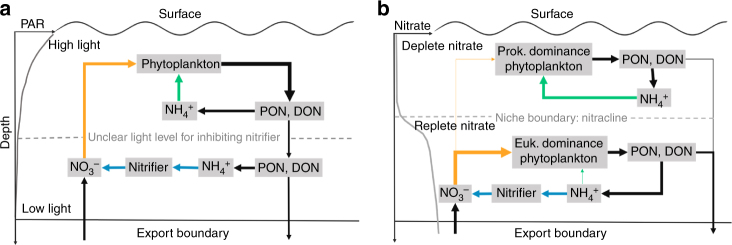Fig. 5.
Conceptual diagrams for the regulation of ammonium transformation pathways. a Conventional view: the control of the vertical distribution of NH4+ assimilation and nitrification in the euphotic ocean is separation by light: phytoplankton dominate NH4+ consumption at high-light intensity, and reduced light inhibition enables nitrifiers to dominate NH4+ consumption at greater depth. However, the light level for inhibition shows large temporal-spatial variations and thus the niche boundary for nitrifiers is unclear. b Amended view: ambient NO3− exerts important influence on the competition for NH4+ by nitrifiers versus phytoplankton via determining phytoplankton community structure, and thus, the affinity of phytoplankton for NH4+. Above the nitracline, prokaryotes dominate, yielding higher affinity for NH4+; while below the nitracline eukaryotes dominate and use the abundant NO3− as the main nitrogen source, reducing phytoplankton affinity for NH4+ and enabling nitrifiers to dominate ammonium recycling. Thus, the depth of the nitracline represents a predictable boundary for the bifurcation of the fate of ammonium. Blue arrows indicate nitrification; green and orange arrows indicate NH4+ uptake (regenerated production) and NO3− uptake (new production), respectively

